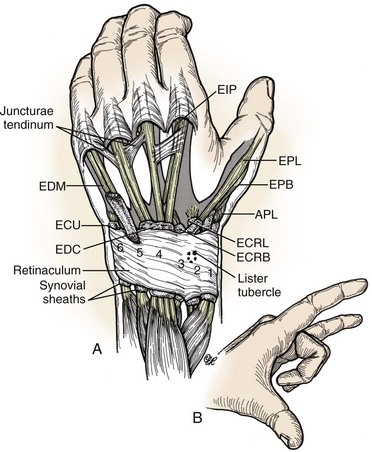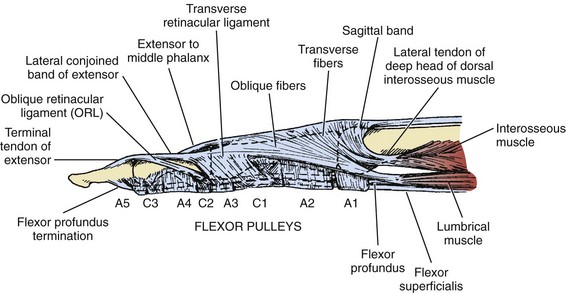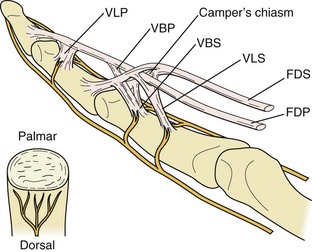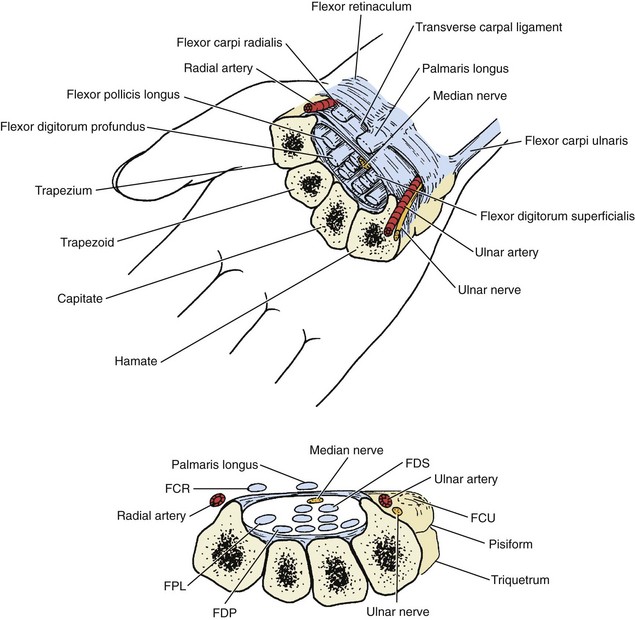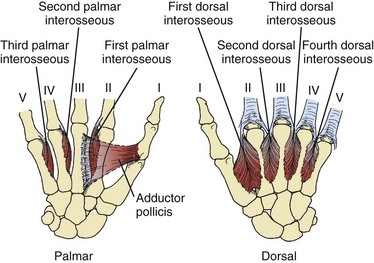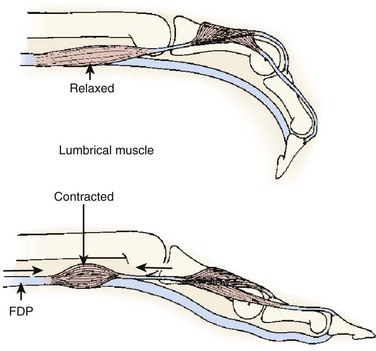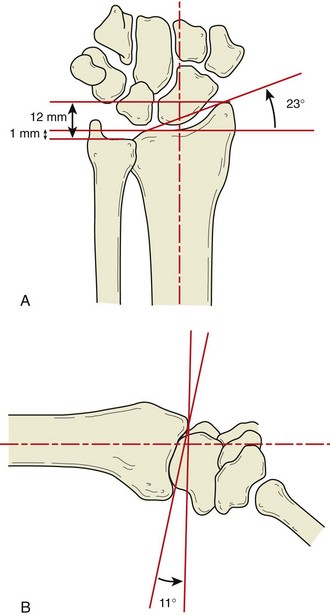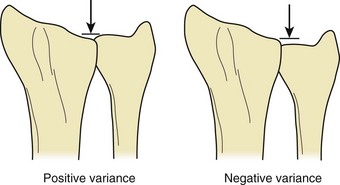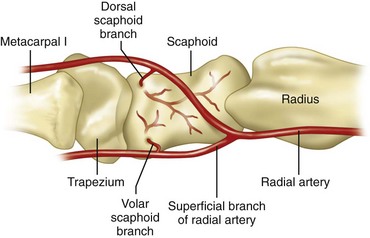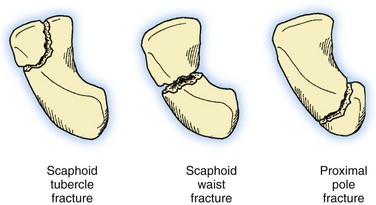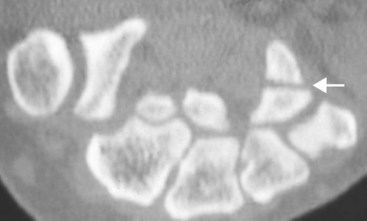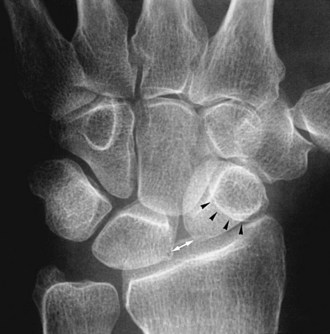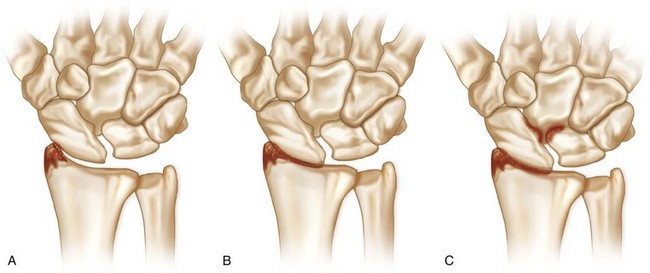Hand, Upper Extremity, and Microvascular Surgery
III. Carpal Fractures and Instability
IV. Metacarpal and Phalangeal Injuries
V. Tendon Injuries and Overuse Syndromes
VI. Distal Radioulnar Joint, Triangular Fibrocartilage Complex, and Wrist Arthroscopy
VII. Nail and Fingertip Injuries
VIII. Soft Tissue Coverage and Microsurgery
XI. Nerve Injuries and Tendon Transfers
XIII. Idiopathic Osteonecrosis of the Carpus
1. Extensor (dorsal) compartments of the wrist (Figure 7-1 and Table 7-1)
2. Extensor retinaculum—prevents tendon bowstringing at wrist
3. Juncturae tendinum—extensor tendon interconnections in hand that may mask proximal tendon lacerations
4. Sagittal bands—aid in metacarpophalangeal (MCP) joint extension, centralize the extensor mechanism, and attach to the volar plate (Figure 7-2)
5. Central slip—inserts on base of middle phalanx (P2), aids in proximal interphalangeal (PIP) joint extension (Figure 7-3)
6. Extensor mechanism receives contributions from the intrinsic muscles—interossei and lumbricals (see Figures 7-3 and 7-4)
7. Lateral bands—receive contributions from common extensor and intrinsics, converge to form terminal extensor tendon, which inserts on base of distal phalanx (P3) (see Figures 7-3 and 7-4)
8. Transverse retinacular ligament—prevents dorsal subluxation of lateral bands (see Figure 7-4)
9. Triangular ligament—prevents volar subluxation of lateral bands (see Figure 7-3)
10. Oblique retinacular ligament (ligament of Landsmeer)—helps to link PIP and distal interphalangeal (DIP) joint extension (see Figure 7-4)
11. Grayson/Cleland ligaments—volar and dorsal to digital neurovascular bundles, respectively (Grayson is ground; Cleland is ceiling)
1. Flexor digitorum profundus (FDP)—flexes the DIP joint, aids in PIP and MCP flexion, typically shares common muscle belly in forearm
2. Flexor digitorum superficialis (FDS)—flexes the PIP joint, aids in MCP flexion, individual muscle bellies in forearm
3. FDP tendon splits FDS at the Campers chiasm at level of proximal phalanx (P1) (Figure 7-5).
4. Flexor tendon sheath—encompasses tendons distal to MCP joint
5. Vascular supply to flexor tendons is twofold.
6. Each digit has five annular pulleys (A1 to A5) and three cruciate pulleys (C1 to C3).
7. Thumb has two annular pulleys and an oblique pulley in between that prevents bowstringing.
8. Carpal tunnel contains median nerve and nine flexor tendons (one flexor pollicis longus [FPL], four FDS, and four FDP tendons).
 FPL tendon—most radial structure in carpal tunnel
FPL tendon—most radial structure in carpal tunnel
 Long and ring FDS tendons are volar to index and small FDS (Figure 7-7).
Long and ring FDS tendons are volar to index and small FDS (Figure 7-7).
9. The Guyon canal (ulnar tunnel)—contains the ulnar nerve and artery
10. Linburg sign—interconnections between FPL and index FDP in forearm; unilateral in 25% to 30%, bilateral in 5% to 15%
11. Palmaris longus (PL) tendon—present 80% to 85% of the time, common source of autograft for upper extremity reconstructive procedures
12. Flexor carpi radialis (FCR)/flexor carpi ulnaris (FCU)—primary wrist flexors, insert on base of second metacarpal and pisiform, respectively
1. Four dorsal interosseous (digit abductors) and three palmar interosseous (digit adductor) muscles
2. Lumbrical muscles originate on radial aspect of FDP tendons and pass volar to transverse metacarpal ligaments to insert on the radial aspect of the extensor hood lateral bands.
 Contribute to interphalangeal joint extension through radial lateral bands, relax extrinsic flexor system (Figure 7-9)
Contribute to interphalangeal joint extension through radial lateral bands, relax extrinsic flexor system (Figure 7-9)
3. Intrinsic tightness—PIP flexion less with MCP joints held in extension (intrinsics on stretch, extrinsics relaxed)
4. Extrinsic tightness—PIP flexion less with MCP joints held in flexion (extrinsics on stretch, intrinsics relaxed)
1. Entire hand supplied by branches of median, radial, and ulnar nerves
2. Sensory innervation of hand—Figure 7-10
3. Median nerve—innervates pronator teres, FDS, FCR, PL, radial two lumbricals
 Anterior interosseous branch of median nerve—innervates FPL, index and long FDP (50% of time), pronator quadratus
Anterior interosseous branch of median nerve—innervates FPL, index and long FDP (50% of time), pronator quadratus
 Palmar cutaneous branch of median nerve—usually lies between PL and FCR at distal wrist flexion crease
Palmar cutaneous branch of median nerve—usually lies between PL and FCR at distal wrist flexion crease
 Recurrent motor branch of median nerve—innervates abductor pollicis brevis, opponens pollicis, and superficial head of flexor pollicis brevis
Recurrent motor branch of median nerve—innervates abductor pollicis brevis, opponens pollicis, and superficial head of flexor pollicis brevis
4. Ulnar nerve—innervates FCU, ring/small FDP (50% of time), ulnar two lumbricals
 Deep motor branch of ulnar nerve—innervates hypothenar and interosseous muscles, adductor pollicis, and deep head of flexor pollicis brevis
Deep motor branch of ulnar nerve—innervates hypothenar and interosseous muscles, adductor pollicis, and deep head of flexor pollicis brevis
5. Martin-Gruber anastomoses—crossover variations between median and ulnar nerves, approximately 15% of population
6. Radial nerve proper—innervates lateral portion of brachialis (also musculocutaneous), triceps, anconeus, brachioradialis, extensor carpi radialis longus (ECRL)
 Divides into superficial sensory branch and posterior interosseous nerve (PIN), which innervates remaining extensor muscles
Divides into superficial sensory branch and posterior interosseous nerve (PIN), which innervates remaining extensor muscles
 Extensor carpi radialis brevis (ECRB) has variable innervation.
Extensor carpi radialis brevis (ECRB) has variable innervation.
 Terminal branch of PIN—lies at floor of fourth extensor compartment
Terminal branch of PIN—lies at floor of fourth extensor compartment
7. Proper digital nerves lie volar to proper digital arteries.
8. Vascular anatomy is covered in the section Vascular Disorders.
1. Most common fracture of the upper extremity (>300,000 per year in United States)
2. High-energy trauma in young
3. Low-energy falls in elderly persons with osteoporotic bone
1. Distal radius articular surface—biconcave, scaphoid and lunate facets
2. Distal radioulnar joint (DRUJ)—articulation with ulna at sigmoid notch
3. Lister tubercle—small dorsal prominence, landmark for dorsal approach to wrist
4. Metaphysis—thin cortex, vulnerable to bending forces
1. Pain, swelling, and deformity at the wrist after trauma
2. Open injuries more common in young patients
3. Examine for concurrent anatomic snuffbox and ulnar-sided tenderness.
4. Evaluate the shoulder and elbow.
5. Assess median and ulnar nerve function.
 Acute carpal tunnel syndrome—characterized by progressive, evolving paresthesias and disproportionate pain; requires emergency median nerve decompression (carpal tunnel release)
Acute carpal tunnel syndrome—characterized by progressive, evolving paresthesias and disproportionate pain; requires emergency median nerve decompression (carpal tunnel release)
 Mild, vague, and nonprogressive sensory dysfunction is not indicative of acute carpal tunnel syndrome.
Mild, vague, and nonprogressive sensory dysfunction is not indicative of acute carpal tunnel syndrome.
 Ulnar nerve palsy after high-energy displaced distal radius fractures has also been described.
Ulnar nerve palsy after high-energy displaced distal radius fractures has also been described.
D Radiographic evaluation (posteroanterior, lateral, and oblique views)
5. Volar tilt (lunate fossa inclination)
6. Ulnar variance—neutral (normal), positive, or negative
8. Associated fractures—ulnar styloid, distal ulna, carpus
 Isolated fracture of radial styloid (chauffeur’s fracture)—may be associated with scapholunate ligament disruption
Isolated fracture of radial styloid (chauffeur’s fracture)—may be associated with scapholunate ligament disruption
 Radiocarpal dislocation may be purely ligamentous or associated with styloid fractures (radial and/or ulnar).
Radiocarpal dislocation may be purely ligamentous or associated with styloid fractures (radial and/or ulnar).
9. Other imaging studies—computed tomography (CT) for detail of complex intraarticular patterns; magnetic resonance imaging (MRI) for occult fracture, bone contusion, associated soft tissue injury
2. Common eponyms (Colles, Smith, Barton, Hutchinson) predate radiography.
3. Over 10 other schemes exist (e.g., AO, Frykman, Fernandez, Melone, Mayo) but largely fail to help predict treatment or prognosis.
1. General goals—maintain reduction until union, restore function, prevent symptomatic post-traumatic radiocarpal osteoarthrosis
2. Factors considered—age, medical condition, activity demands, bone quality, fracture stability, associated injuries
 Definitive cast immobilization (favored over removable splints) sufficient in minimally displaced low-energy injuries, especially in functionally low-demand patients
Definitive cast immobilization (favored over removable splints) sufficient in minimally displaced low-energy injuries, especially in functionally low-demand patients
 Closed reduction indicated in displaced fractures with abnormal radiographic parameters, especially in functionally high-demand patients
Closed reduction indicated in displaced fractures with abnormal radiographic parameters, especially in functionally high-demand patients
 Dorsal hematoma block with local anesthetic
Dorsal hematoma block with local anesthetic
 Finger traps, upper arm counterweight for ligamentotaxis
Finger traps, upper arm counterweight for ligamentotaxis
 Recreate deformity, manipulate distal fragment.
Recreate deformity, manipulate distal fragment.
 Sugar tong plaster splint with three-point mold
Sugar tong plaster splint with three-point mold
 Keep MCP and interphalangeal joints free for motion.
Keep MCP and interphalangeal joints free for motion.
 Radiographs obtained weekly for first 3 weeks
Radiographs obtained weekly for first 3 weeks
 Loss of reduction correlates with increasing age.
Loss of reduction correlates with increasing age.
 Postreduction benchmarks (American Academy of Orthopaedic Surgeons guideline)
Postreduction benchmarks (American Academy of Orthopaedic Surgeons guideline)
 Immobilization for 6 to 8 weeks (no evidence to support any particular type)
Immobilization for 6 to 8 weeks (no evidence to support any particular type)
 Wrist and digit stiffness, muscle atrophy, and disuse osteopenia may result from prolonged immobilization.
Wrist and digit stiffness, muscle atrophy, and disuse osteopenia may result from prolonged immobilization.
 Closed reduction and percutaneous pinning (CRPP)
Closed reduction and percutaneous pinning (CRPP)
 Open reduction with internal fixation (ORIF)
Open reduction with internal fixation (ORIF)
 Approach between third and fourth extensor compartments
Approach between third and fourth extensor compartments
 Articular reduction directly visualized
Articular reduction directly visualized
 Best for dorsally displaced fractures with dorsal bony defects
Best for dorsally displaced fractures with dorsal bony defects
 Historical disadvantage—extensor tendon irritation/rupture from prominent hardware
Historical disadvantage—extensor tendon irritation/rupture from prominent hardware
 Henry approach between FCR and radial artery or through floor of FCR tendon sheath
Henry approach between FCR and radial artery or through floor of FCR tendon sheath
 Articular reduction not directly visualized, relies on fluoroscopic guidance
Articular reduction not directly visualized, relies on fluoroscopic guidance
 Fixed-angle and variable-angle plates available
Fixed-angle and variable-angle plates available
 Best for Smith and Barton fracture patterns, increasingly used for dorsally displaced injuries
Best for Smith and Barton fracture patterns, increasingly used for dorsally displaced injuries
 Evidence does not support any advantage of early versus delayed motion recovery after surgical fixation of distal radius.
Evidence does not support any advantage of early versus delayed motion recovery after surgical fixation of distal radius.
 Concurrent treatment of ulnar styloid fracture not routinely necessary
Concurrent treatment of ulnar styloid fracture not routinely necessary
 Median nerve dysfunction is the most common complication following a distal radius fracture.
Median nerve dysfunction is the most common complication following a distal radius fracture.
 Extensor pollicis longus (EPL) tendon rupture
Extensor pollicis longus (EPL) tendon rupture
 Most commonly occurs as a late complication following closed treatment because of attritional wear and/or vascular insufficiency near the Lister tubercle
Most commonly occurs as a late complication following closed treatment because of attritional wear and/or vascular insufficiency near the Lister tubercle
 Typically presents as a painless, acute loss of thumb extension
Typically presents as a painless, acute loss of thumb extension
 Treat with PL intercalary autograft or extensor indicis proprius (EIP)-to-EPL tendon transfer.
Treat with PL intercalary autograft or extensor indicis proprius (EIP)-to-EPL tendon transfer.
 Asymptomatic malunion in a functionally low-demand patient does not require treatment.
Asymptomatic malunion in a functionally low-demand patient does not require treatment.
 Low-demand patients with pain from ulnocarpal impaction may benefit from a distal ulna resection (Darrach procedure).
Low-demand patients with pain from ulnocarpal impaction may benefit from a distal ulna resection (Darrach procedure).
 A corrective radius osteotomy with ORIF and bone grafting may be indicated for high-demand patients.
A corrective radius osteotomy with ORIF and bone grafting may be indicated for high-demand patients.
 Presence of radiocarpal osteoarthrosis following intraarticular distal radius fracture with residual step-off is prevalent but does not necessarily correlate with patient-reported symptoms.
Presence of radiocarpal osteoarthrosis following intraarticular distal radius fracture with residual step-off is prevalent but does not necessarily correlate with patient-reported symptoms.
 Multiple case reports of flexor tendon ruptures after volar plating
Multiple case reports of flexor tendon ruptures after volar plating
 FPL is the most common rupture after volar locking plating.
FPL is the most common rupture after volar locking plating.
 EPL is the most common extensor tendon injured, potentially due to drill-bit penetration or prominent screws.
EPL is the most common extensor tendon injured, potentially due to drill-bit penetration or prominent screws.
 Vitamin C in doses of at least 500 mg/day may decrease the incidence of complex regional pain syndrome (disproportionate pain).
Vitamin C in doses of at least 500 mg/day may decrease the incidence of complex regional pain syndrome (disproportionate pain).
III CARPAL FRACTURES AND INSTABILITY
1. Eight carpal bones aligned in two rows
2. Proximal row—scaphoid, lunate, and triquetrum
3. Distal row—trapezium, trapezoid, capitate, and hamate
4. Pisiform is sesamoid within the FCU tendon.
5. Dart-thrower’s motion is combined wrist extension–radial deviation to wrist flexion–ulnar deviation.
6. Carpus has a rich vascular supply with multiple anastomoses.
7. Scaphoid, lunate, and capitate may each have large area supplied by a single interosseous vessel.
8. Some evidence suggests a proprioceptive role for the terminal branch of the posterior interosseous nerve, which may be compromised when this branch is sacrificed during dorsal approaches to the wrist.
1. Most common carpal fracture (Table 7-2), accounting for up to 15% of all acute wrist injuries
Table 7-2
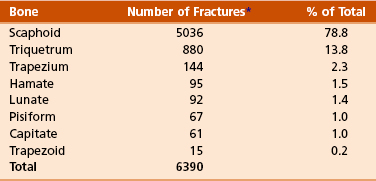
*The number of fractures represents a total of 6390 fractures compiled from three referenced studies to accumulate incidence of carpal bone fractures.
From Green DP, et al, editors: Green’s operative hand surgery, ed 5, Philadelphia, 2005, Churchill Livingstone, p 711.
 Approximately 75% covered by articular cartilage
Approximately 75% covered by articular cartilage
 Main blood supply comes from a dorsal branch of the radial artery, enters at dorsal ridge just distal to waist, and flows in retrograde fashion toward proximal pole.
Main blood supply comes from a dorsal branch of the radial artery, enters at dorsal ridge just distal to waist, and flows in retrograde fashion toward proximal pole.
 Additional branches off superficial volar branch of radial artery enter at distal tubercle and perfuse distal one third.
Additional branches off superficial volar branch of radial artery enter at distal tubercle and perfuse distal one third.
 Tenuous vascular anatomy renders waist and proximal pole fractures at risk for nonunion and post-traumatic osteonecrosis (Figure 7-13).
Tenuous vascular anatomy renders waist and proximal pole fractures at risk for nonunion and post-traumatic osteonecrosis (Figure 7-13).
 Suspect when chief complaint is radial-sided wrist pain after injury or trauma
Suspect when chief complaint is radial-sided wrist pain after injury or trauma
 Most common mechanism is forced hyperextension and radial deviation of the wrist.
Most common mechanism is forced hyperextension and radial deviation of the wrist.
 This results in force transmission through the radioscaphoid articulation and concentration at the scaphoid.
This results in force transmission through the radioscaphoid articulation and concentration at the scaphoid.
 Swelling, anatomic snuffbox/volar tubercle tenderness, limited wrist motion
Swelling, anatomic snuffbox/volar tubercle tenderness, limited wrist motion
 Posteroanterior, lateral, oblique, and scaphoid radiographic views
Posteroanterior, lateral, oblique, and scaphoid radiographic views
 Scaphoid view—approximately 30 degrees of wrist extension and approximately 20 degrees of ulnar deviation
Scaphoid view—approximately 30 degrees of wrist extension and approximately 20 degrees of ulnar deviation
 Radiographs initially nondiagnostic in more than 30% of cases
Radiographs initially nondiagnostic in more than 30% of cases
 With negative radiographs and high clinical suspicion, thumb spica splint immobilization and repeat examination and radiographs in 2 weeks
With negative radiographs and high clinical suspicion, thumb spica splint immobilization and repeat examination and radiographs in 2 weeks
 Bone scan, ultrasonography, CT, and MRI have all been used for earlier diagnosis.
Bone scan, ultrasonography, CT, and MRI have all been used for earlier diagnosis.
 MRI has highest sensitivity, specificity, and accuracy (all >95%) with high positive and negative predictive values.
MRI has highest sensitivity, specificity, and accuracy (all >95%) with high positive and negative predictive values.
 CT has lower predictive values.
CT has lower predictive values.
 Bone scan and ultrasonography lowest specificity and positive predictive value
Bone scan and ultrasonography lowest specificity and positive predictive value
 All of these are better for ruling out rather than ruling in a scaphoid fracture.
All of these are better for ruling out rather than ruling in a scaphoid fracture.
 Neglect of injury for 4 weeks increases nonunion rate from approximately 5% to 45%.
Neglect of injury for 4 weeks increases nonunion rate from approximately 5% to 45%.
 Cast immobilization for nondisplaced fractures
Cast immobilization for nondisplaced fractures
 There is no evidence to suggest that the type of cast affects outcome (e.g., long-arm versus short-arm, standard versus additional thumb spica component).
There is no evidence to suggest that the type of cast affects outcome (e.g., long-arm versus short-arm, standard versus additional thumb spica component).
 Expected time to union increases and overall union rate decreases as the fracture becomes more proximal.
Expected time to union increases and overall union rate decreases as the fracture becomes more proximal.
 Consequently, length of cast immobilization should be greater for more proximal fractures.
Consequently, length of cast immobilization should be greater for more proximal fractures.
 Indications include greater than 1 mm displacement, intrascaphoid angle greater than 35 degrees (humpback deformity), and trans-scaphoid perilunate dislocation.
Indications include greater than 1 mm displacement, intrascaphoid angle greater than 35 degrees (humpback deformity), and trans-scaphoid perilunate dislocation.
 Proximal pole fracture is also a relative indication
Proximal pole fracture is also a relative indication
 Minimally displaced fractures may be treated with percutaneous internal fixation.
Minimally displaced fractures may be treated with percutaneous internal fixation.
 Commonly performed via a dorsal approach
Commonly performed via a dorsal approach
 Direct visualization of the screw via a limited incision is recommended to ensure seating of the screw in subchondral bone.
Direct visualization of the screw via a limited incision is recommended to ensure seating of the screw in subchondral bone.
 Formal ORIF with headless compression screw for displaced injuries
Formal ORIF with headless compression screw for displaced injuries
 Approach dictated by fracture location and surgeon preference
Approach dictated by fracture location and surgeon preference
 Volar approach potentially avoids disruption to the blood supply of the scaphoid and is the most commonly employed approach.
Volar approach potentially avoids disruption to the blood supply of the scaphoid and is the most commonly employed approach.
 Union rates of over 90% to 95% expected
Union rates of over 90% to 95% expected
 Aggressive physical therapy typically delayed until radiographic union achieved
Aggressive physical therapy typically delayed until radiographic union achieved
 Include nonunion, malunion, osteonecrosis, and post-traumatic osteoarthrosis
Include nonunion, malunion, osteonecrosis, and post-traumatic osteoarthrosis
 Symptomatic, early-stage scaphoid nonunion may be treated with ORIF and bone grafting.
Symptomatic, early-stage scaphoid nonunion may be treated with ORIF and bone grafting.
 Inlay (Russe) technique best used in cases with minimal deformity and vascularized proximal pole
Inlay (Russe) technique best used in cases with minimal deformity and vascularized proximal pole
 Scaphoid nonunion with accompanying humpback deformity requires open-wedge interposition (Fisk) graft to restore scaphoid length and angulation.
Scaphoid nonunion with accompanying humpback deformity requires open-wedge interposition (Fisk) graft to restore scaphoid length and angulation.
 Grafts obtained from distal radius or iliac crest
Grafts obtained from distal radius or iliac crest
 Most surgeons typically use supplemental headless compression screw in nonunion cases.
Most surgeons typically use supplemental headless compression screw in nonunion cases.
 Presence of intraoperative punctate bleeding is most reliable sign of vascular proximal pole.
Presence of intraoperative punctate bleeding is most reliable sign of vascular proximal pole.
 Vascularized bone grafting has gained popularity in nonunions with avascular proximal pole.
Vascularized bone grafting has gained popularity in nonunions with avascular proximal pole.
 Most commonly harvested from dorsal aspect of distal radius, based on 1,2 intercompartmental supraretinacular artery (1,2 ICSRA)
Most commonly harvested from dorsal aspect of distal radius, based on 1,2 intercompartmental supraretinacular artery (1,2 ICSRA)
 Untreated, chronic scaphoid nonunion may lead to characteristic progression of post-traumatic osteoarthrosis called scaphoid nonunion advanced collapse (SNAC) wrist.
Untreated, chronic scaphoid nonunion may lead to characteristic progression of post-traumatic osteoarthrosis called scaphoid nonunion advanced collapse (SNAC) wrist.
 Distal portion flexes, while proximal pole is tethered by intact scapholunate ligament and follows lunate into extension. This produces the humpback deformity.
Distal portion flexes, while proximal pole is tethered by intact scapholunate ligament and follows lunate into extension. This produces the humpback deformity.
 Options for treatment of SNAC wrist include radial styloidectomy, proximal row carpectomy, scaphoid excision and four-corner (bone) fusion, and total wrist fusion, depending on stage of presentation and surgeon preference.
Options for treatment of SNAC wrist include radial styloidectomy, proximal row carpectomy, scaphoid excision and four-corner (bone) fusion, and total wrist fusion, depending on stage of presentation and surgeon preference.
C Other carpal bone fractures—small fraction of wrist injuries (see Table 7-2)
1. Lunate—rarely encountered in isolation
2. Capitate neck—may occur in combination with scaphoid fracture or perilunate dislocation, treated with ORIF or intercarpal fusion
3. Triquetrum—Majority of injuries are dorsal capsular avulsion fractures (wrist sprain) and require only brief period of immobilization.
4. Hook of hamate—often from blunt trauma to palm, frequently associated with certain sports (e.g., golf, baseball, hockey, racquet sports)
 Imaging—carpal tunnel view, CT scan (Figure 7-15)
Imaging—carpal tunnel view, CT scan (Figure 7-15)
 Symptomatic patients who fail trial of cast immobilization are treated with fracture fragment excision.
Symptomatic patients who fail trial of cast immobilization are treated with fracture fragment excision.
 ORIF has been described for larger fracture fragments but has high complication rate and little clinical benefit.
ORIF has been described for larger fracture fragments but has high complication rate and little clinical benefit.
 Flexor tendon rupture may be seen with chronic nonunion.
Flexor tendon rupture may be seen with chronic nonunion.
 Be aware of the bipartite hamate, which may be differentiated from a fracture by smooth cortical surfaces.
Be aware of the bipartite hamate, which may be differentiated from a fracture by smooth cortical surfaces.
1. Disruption of normal kinematics of wrist
2. Characterized by wrist pain, loss of motion, weakness
3. If untreated, may lead to degenerative arthritis and disability
4. Spectrum of injury from occult (predynamic) to dynamic to static
5. Static instability detected on standard radiographs, whereas dynamic instability requires either stress radiographs requires either stress radiographs, cineradiography, or live fluoroscopy
6. Carpal instability dissociative (CID) describes instability between individual carpal bones of single carpal row.
 Examples include classical patterns of dorsal intercalated segmental instability (DISI) and volar intercalated segmental instability (VISI) (Figure 7-16).
Examples include classical patterns of dorsal intercalated segmental instability (DISI) and volar intercalated segmental instability (VISI) (Figure 7-16).
7. Carpal instability nondissociative (CIND) describes instability between carpal rows, such as midcarpal or radiocarpal instability.
8. Carpal instability resulting from malunited distal radius fracture is an example of carpal instability adaptive.
9. Perilunate dislocations combine CID and CIND and are classified as carpal instability complex.
 DISI—most common form of carpal instability
DISI—most common form of carpal instability
 Scapholunate ligament disruption
Scapholunate ligament disruption
 Dorsal fibers are stronger than volar fibers.
Dorsal fibers are stronger than volar fibers.
 Secondary injury to stabilizing dorsal and/or volar extrinsic ligaments, volar scaphoid-trapezo-trapezoid ligaments
Secondary injury to stabilizing dorsal and/or volar extrinsic ligaments, volar scaphoid-trapezo-trapezoid ligaments
 Scaphoid hyperflexion and lunate hyperextension
Scaphoid hyperflexion and lunate hyperextension
 May be traumatic or result from inflammatory or crystalline arthropathy
May be traumatic or result from inflammatory or crystalline arthropathy
 Dorsal wrist pain, often with loading
Dorsal wrist pain, often with loading
 Reproduction of pain/palpable clunk with scaphoid shift test (dorsally directed pressure over volar scaphoid tubercle while wrist brought from ulnar to radial deviation subluxates or dislocates scaphoid over dorsal ridge of distal radius that when released causes scaphoid to reduce with painful clunk) (Figure 7-17)
Reproduction of pain/palpable clunk with scaphoid shift test (dorsally directed pressure over volar scaphoid tubercle while wrist brought from ulnar to radial deviation subluxates or dislocates scaphoid over dorsal ridge of distal radius that when released causes scaphoid to reduce with painful clunk) (Figure 7-17)
 Standard radiographs may reveal cortical ring sign (Figure 7-18), increased scapholunate angle (>70 degrees), or widened scapholunate interval (>3 mm) in static DISI.
Standard radiographs may reveal cortical ring sign (Figure 7-18), increased scapholunate angle (>70 degrees), or widened scapholunate interval (>3 mm) in static DISI.
 Bilateral clenched-fist (anteroposterior grip) comparison views may reveal a dynamic DISI with relatively widened scapholunate interval on affected side (stress radiographs).
Bilateral clenched-fist (anteroposterior grip) comparison views may reveal a dynamic DISI with relatively widened scapholunate interval on affected side (stress radiographs).
 MRI best, but not perfect, for detection of scapholunate ligament injury (see Figure 7-18)
MRI best, but not perfect, for detection of scapholunate ligament injury (see Figure 7-18)
 Gold standard is wrist arthroscopy.
Gold standard is wrist arthroscopy.
 Geissler classification (Table 7-3)
Geissler classification (Table 7-3)
Table 7-3
Geissler Classification of Arthroscopic Scapholunate Ligament Disruption
| Grade | Description |
| I | Attenuation or hemorrhage of interosseous ligament as seen from radiocarpal space. No incongruity of carpal alignment in midcarpal space. |
| II | Attenuation or hemorrhage of interosseous ligament as seen from radiocarpal space. There may be a slight gap (less than width of probe) between carpal bones in midcarpal space. |
| III | Incongruity or step-off of carpal alignment as seen from both radiocarpal and midcarpal space. Probe may be passed through gap between carpal bones. |
| IV | Incongruity or step-off of carpal alignment as seen from both radiocarpal and midcarpal space. There is gross instability with manipulation. A 2.7-mm arthroscope may be passed through the gap between carpal bones (“drive-through sign”). |
 Treatment depends on stage of instability.
Treatment depends on stage of instability.
 Partial injuries may improve with nonoperative treatment or arthroscopic débridement.
Partial injuries may improve with nonoperative treatment or arthroscopic débridement.
 Acute scapholunate ligament rupture may be amenable to primary repair.
Acute scapholunate ligament rupture may be amenable to primary repair.
 Delayed treatment may require open reduction of scapholunate interval and pinning with or without dorsal capsulodesis.
Delayed treatment may require open reduction of scapholunate interval and pinning with or without dorsal capsulodesis.
 Limited clinical data on reduction-association of scaphoid and lunate (RASL) procedure
Limited clinical data on reduction-association of scaphoid and lunate (RASL) procedure
 Tendon and bone-retinaculum-bone grafts have been attempted for scapholunate reconstruction.
Tendon and bone-retinaculum-bone grafts have been attempted for scapholunate reconstruction.
 Cases of chronic, static instability may result in scapholunate advanced collapse (SLAC wrist).
Cases of chronic, static instability may result in scapholunate advanced collapse (SLAC wrist).
 Three stages are described (Figure 7-19).
Three stages are described (Figure 7-19).
 Radioscaphoid and capitolunate joints are affected, radiolunate joint is spared.
Radioscaphoid and capitolunate joints are affected, radiolunate joint is spared.
 Treatment depends on condition of articular surfaces and competency of radioscaphocapitate ligament.
Treatment depends on condition of articular surfaces and competency of radioscaphocapitate ligament.
 Options include radial styloidectomy, proximal row carpectomy, scaphoid excision and four-corner fusion, total wrist fusion.
Options include radial styloidectomy, proximal row carpectomy, scaphoid excision and four-corner fusion, total wrist fusion.
 VISI—second most common form of carpal instability
VISI—second most common form of carpal instability
 Disruption of lunotriquetral interosseous ligament
Disruption of lunotriquetral interosseous ligament
 Volar fibers are stronger than dorsal fibers.
Volar fibers are stronger than dorsal fibers.
 Accompanying injury of the dorsal extrinsic ligaments may result in static instability.
Accompanying injury of the dorsal extrinsic ligaments may result in static instability.
 Both the scaphoid and lunate tilt volarly.
Both the scaphoid and lunate tilt volarly.
 Radiographs may show break in Gilula arc on posteroanterior view and decreased scapholunate angle on lateral view.
Radiographs may show break in Gilula arc on posteroanterior view and decreased scapholunate angle on lateral view.
 MRI may show pathology of lunotriquetral ligament.
MRI may show pathology of lunotriquetral ligament.
 Clunking wrist that may or may not be painful
Clunking wrist that may or may not be painful
 Many patient have generalized ligamentous laxity.
Many patient have generalized ligamentous laxity.
 History of trauma often absent
History of trauma often absent
 Sudden shift of proximal carpal row with active radial or ulnar deviation (cineradiographic studies)
Sudden shift of proximal carpal row with active radial or ulnar deviation (cineradiographic studies)
 Radiocarpal dislocation (CIND)
Radiocarpal dislocation (CIND)
 May be associated with intracarpal injury, acute carpal tunnel syndrome, possible compartment syndrome, other major musculoskeletal and/or organ injuries
May be associated with intracarpal injury, acute carpal tunnel syndrome, possible compartment syndrome, other major musculoskeletal and/or organ injuries
 Volar more severe than dorsal dislocation
Volar more severe than dorsal dislocation
 May be purely ligamentous or include radial and/or ulnar styloid fractures
May be purely ligamentous or include radial and/or ulnar styloid fractures
 Ulnar translocation of the carpus signifies global ligamentous disruption.
Ulnar translocation of the carpus signifies global ligamentous disruption.
 Moneim proposed two types based on accompanying intracarpal fracture or interosseous ligament injury
Moneim proposed two types based on accompanying intracarpal fracture or interosseous ligament injury
 Dumontier and Graham stressed the distinction between injuries with small versus large radial styloid fractures.
Dumontier and Graham stressed the distinction between injuries with small versus large radial styloid fractures.
 ORIF of styloid fractures may be enough to restore stability.
ORIF of styloid fractures may be enough to restore stability.
 May also require direct ligamentous repair and/or external fixation to neutralize forces
May also require direct ligamentous repair and/or external fixation to neutralize forces
 Carpal instability adaptive from distal radius malunion
Carpal instability adaptive from distal radius malunion
 Perilunate dislocations (carpal instability complex)
Perilunate dislocations (carpal instability complex)
 Potentially devastating injuries resulting from forced dorsiflexion, ulnar deviation, and supination of wrist
Potentially devastating injuries resulting from forced dorsiflexion, ulnar deviation, and supination of wrist
 Approximately 25% of cases may be missed in the emergency department
Approximately 25% of cases may be missed in the emergency department
 Mayfield described four stages of perilunar disruption of ligamentous constraints, proceeding in counterclockwise direction
Mayfield described four stages of perilunar disruption of ligamentous constraints, proceeding in counterclockwise direction
 Stage I—scapholunate disruption
Stage I—scapholunate disruption
 Stage II—scaphocapitate disruption
Stage II—scaphocapitate disruption
 Stage III—lunotriquetral disruption
Stage III—lunotriquetral disruption
 Stage IV—circumferential disruption
Stage IV—circumferential disruption


